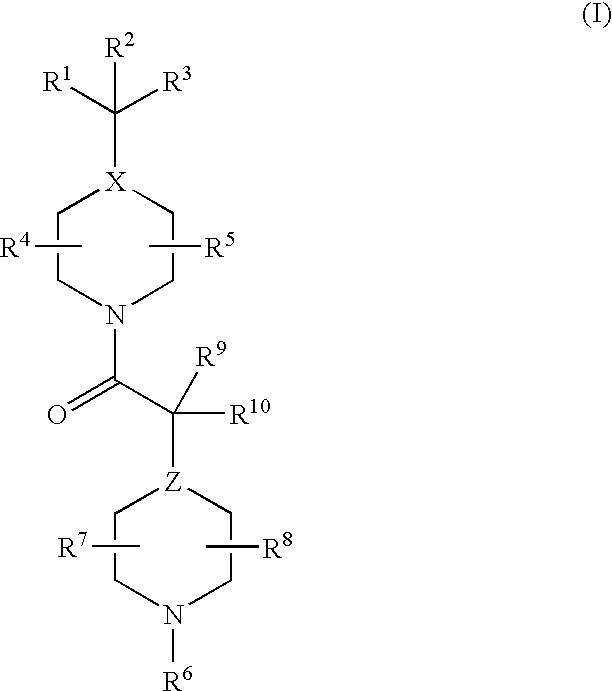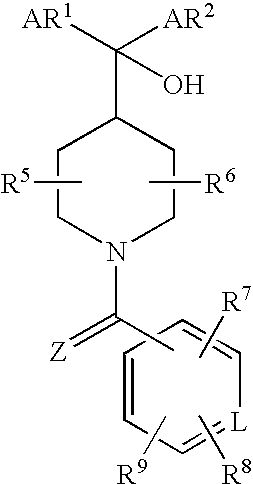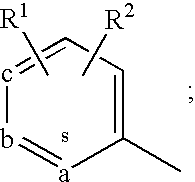17β-hydroxysteroid dehydrogenase type 3 inhibitors for the treatment of androgen dependent diseases
a 17-hydroxysteroid dehydrogenase, androgen-dependent technology, applied in the direction of biocide, animal repellents, drug compositions, etc., can solve the problems of unwanted side effects of therapies, and achieve the effect of reducing androgen synthesis or activity, treating or preventing hair loss
- Summary
- Abstract
- Description
- Claims
- Application Information
AI Technical Summary
Benefits of technology
Problems solved by technology
Method used
Image
Examples
example 1
PREPARATIVE EXAMPLE 1
[0256]
[0257]To a solution of DCC (43.2 mL, 1.0 M in CH2Cl2, 1.0 eq.) in CH2Cl2 (200 mL) at 0° C. was added N-t-BOC-L-leucine (10 g, 43.2 mmol). To the resulting slurry was added ethyl N-benzylglycinate (8.1 mL, 1.0 eq.) over 15 minutes. The resulting solution was stirred at 0° C. for 2 hours and room temperature 1 hour, filtered and the concentrated to give an oil (20.7 g, LCMS: MH+=407). The intermediate was dissolved in CH2Cl2 (150 mL) through which HCl (g) was bubbled for 4 hours. The solution was purged with N2 and concentrated under reduced pressure. The residue was neutralized with saturated NaHCO3 and extracted with EtOAc (3×200 mL). The combined organics were washed with water, dried over Na2SO4, filtered and concentrated to give a solid which was used without further purification (11.3 g, 100% yield). LCMS: MH+=261.
PREPARATIVE EXAMPLE 2-5.10
[0258]By essentially the same procedure set forth in Preparative Example 1, using the appropriate amino acids list...
example 6
PREPARATIVE EXAMPLE 6
[0260]
[0261]To a solution of (S)-3-isopropyl-2,5-piperazinedione (5.0 g, 32 mmol) in THF (100 mL) at 0° C. was added LAH (137 mL, 1.0 M in THF, 4.3 eq.) dropwise. After the addition was complete, the resulting solution was heated to reflux overnight. The reaction mixture was cooled to room temperature and quenched by the slow, sequential addition of water (5.23 mL), 1N NaOH (5.23 mL), and water (5.23 mL). The resulting slurry was diluted with EtOAc and filtered through a plug of Celite. The residue was washed with EtOAc (4×100 mL) and the combined organics concentrated under reduced pressure. The crude product was purified by flash chromatography using a gradient of 5% MeOH, 10% MeOH, 5% (10% NH4OH) in MeOH, 10% (10% NH4OH) in MeOH, and 20% (10% NH4OH) in MeOH in CH2Cl2 to give a solid (3.03 g, 74% yield). LCMS: MH+=129.
PREPARATIVE EXAMPLE 7-13.1
[0262]By essentially the same procedure set forth in Preparative Example 6, using the appropriate piperazinediones lis...
example 14
PREPARATIVE EXAMPLE 14
[0264]
[0265]To a solution of the product from Preparative Example 9 (8.2 g, 31.5 mmol) in CH2Cl2 (300 mL) was added (BOC)2O (7.5 g, 1.02 eq.). The resulting solution was stirred at room temperature overnight. The reaction was quenched by the addition of saturated NaHCO3 and separated. The organic layer was washed with brine, dried over Na2SO4, filtered, and concentrated under reduced pressure. The crude product was purified by flash chromatography using a 10% EtOAc in hexanes solution as eluent (10.6 g, 99% yield). LCMS: MH+=333.
PUM
| Property | Measurement | Unit |
|---|---|---|
| Temperature | aaaaa | aaaaa |
| Temperature | aaaaa | aaaaa |
| Temperature | aaaaa | aaaaa |
Abstract
Description
Claims
Application Information
 Login to View More
Login to View More - R&D
- Intellectual Property
- Life Sciences
- Materials
- Tech Scout
- Unparalleled Data Quality
- Higher Quality Content
- 60% Fewer Hallucinations
Browse by: Latest US Patents, China's latest patents, Technical Efficacy Thesaurus, Application Domain, Technology Topic, Popular Technical Reports.
© 2025 PatSnap. All rights reserved.Legal|Privacy policy|Modern Slavery Act Transparency Statement|Sitemap|About US| Contact US: help@patsnap.com



